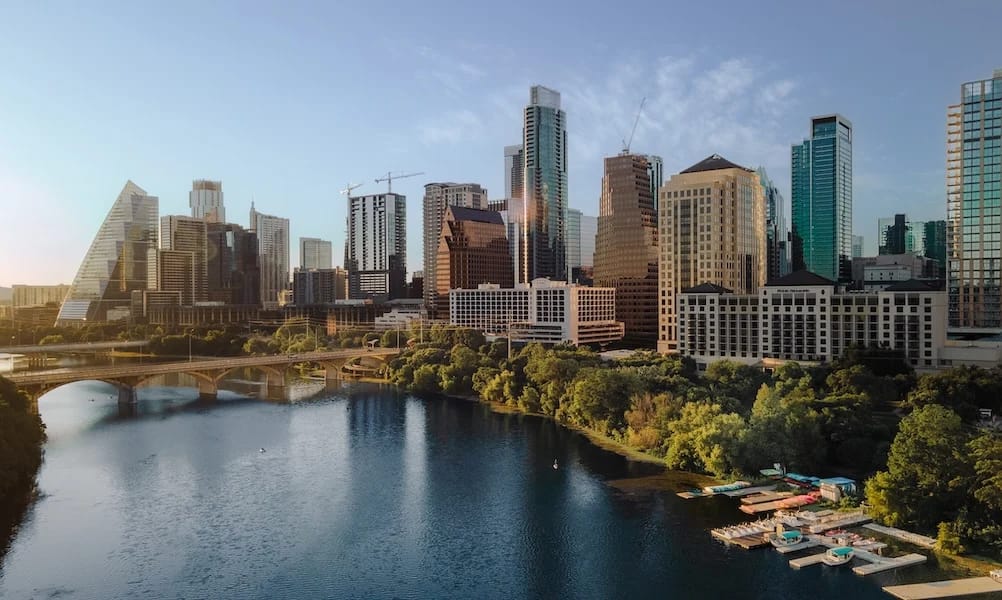
Once the nation’s best-kept secret, an eclectic mix of Western and weird, Austin has experienced a sustained growth spurt in recent years, becoming the 11th-biggest city in the United States. With a population of 979,882 in 2023, according to the U.S. census, the capital of Texas already may have notched its millionth resident as businesses and workers have flocked there.
Austin is home to one of the nation’s leading research institutions, the University of Texas at Austin (UT). And with hundreds of live music venues, the city’s reputation as the Live Music Capital of the World® is secure.
In addition, Austin has become a leading tech hub, having grown its tech workforce by 29.1% from 2018 to 2023—more than any other U.S. city, according to the real estate investment company CBRE. Austin now has approximately 99,460 people working in tech-related jobs, an increase of 22,390 over that five-year span.
“When I first arrived 25 years ago, everybody loved it here and wanted to stay, but there weren’t enough jobs to support that,” said Dr. Gaylen Paulson, associate dean at UT’s Red McCombs School of Business. “Eventually, companies figured out that this is where everybody wants to be, including their leadership, so they started relocating here.”
To accommodate that growth, Austin is in building mode, with a new convention center to be completed in 2029 and a major expansion of Austin-Bergstrom International Airport taking place through 2030. But for association executives and meeting planners, there’s no time like the present to embrace Austin’s unique character.
With help from the city’s tourism stakeholders, Austin is well prepared to win over attendees who have grown tired of visiting the same handful of cities year after year. Here’s a look at how Austin is delivering memorable experiences for event attendees while managing its growing pains.
Wide-Open Event Spaces
The Austin Convention Center closed on April 1, 2025, following one of the city’s signature annual events, the South by Southwest® Conference & Festivals. Following a $1.6 billion redevelopment project, the new convention center will open in 2029, enabling the city to host larger events than ever before.
With 376,000 square feet of rentable space, the existing facility is the 60th-largest convention center in America. The renovation will double the amount of rentable space and place the convention center approximately 35th nationally in terms of square footage.
While the new building is under construction, the Palmer Events Center remains available to host major events. The multipurpose venue next to Butler Metro Park features 70,000 square feet of column-free exhibit halls, along with covered outdoor canopies that provide an additional 50,000 square feet.
Paulson noted that razing the old convention center will cause “some short-term pain” for tourism officials and destination management companies. But given Austin’s goal to be a world-class destination for meetings and events, the city is “making the right call to rip off the Band-Aid.”
“The charm of Austin doesn’t go away during construction,” Paulson said. “This is still an amazing, vibrant city, and there’s been a broad development of great venues here over the past 20 years, so Austin’s meeting spaces have improved and expanded dramatically. The convention center will be offline for a while, but that represents only one type of event. You can still host large, exciting meetings across a variety of venues and tap into Austin’s energy and excitement.”
Robust Hotel Development
The new convention center is part of a downtown building boom aimed at accommodating groups of all sizes. Major renovations of existing hotels and new development have lifted the downtown room inventory to 15,705, up 72% from 2015, according to Visit Austin, the city’s tourism arm. Overall, Austin has approximately 50,591 hotel rooms, an increase of 42% from a decade ago.
Major hotel developments include:
- 1 Hotel Austin is set to open in 2026 in what will soon be Texas’ tallest building, which is under construction in the popular Rainey Street entertainment district, where Waller Creek meets Lady Bird Lake. The 74-story building will feature the hotel as a tenant, offering 251 guest rooms in a mixed-use development that includes office space and apartments.
- Hotel Trinity, with 258 rooms and 6,000 square feet of meeting space, is also scheduled to open in 2026. Located at Trinity and Fifth streets in downtown Austin, the 13-floor hotel will feature a private rooftop pool, fitness center, social club, and ground-floor restaurant.
- Graduate Austin, slated for a 2027 grand opening, will be located blocks from the University of Texas on Guadalupe Street. The mixed-use property will include a boutique hotel with 194 guest rooms, meeting and event space, a ground-floor café, rooftop deck, and retail space.
- Downtown, the W Austin hotel updated its 251 guest rooms and opened three new restaurants in 2024. Likewise, the JW Marriott is renovating its guest rooms and existing 120,000 square feet of event space in 2025.
- Downright Austin, formerly the Sheraton Austin at the Capitol, reopened last year after a rebrand and renovation following its acquisition by Renaissance Hotels. The refurbished property features 367 guest rooms, 31,000 square feet of event space, and two signature dining concepts.
- DoubleTree’s I-35 UT Austin property is planning to build two 25-floor towers on the company’s existing property just north of downtown, creating a mix of hotel rooms, residential units, and amenity decks.
- The AT&T Hotel and Conference Center is set to be renovated in 2025, adding a new junior ballroom and advanced audiovisual technology to its 85,000 square feet of event space, 53 meeting rooms, and 297 guest rooms.
“We have four big hotels that basically surround the convention center, and the city’s overall hotel-room inventory has grown substantially,” said Stephen Genovesi, executive vice president of sales at Visit Austin. “We’re fortunate to have many hotels that have very good meeting space to self-contain events or to collaborate with other hotels to give groups a very walkable, easy layout.”
Airport Expansion Underway
Austin-Bergstrom International Airport served a record 22 million passengers in 2023, up 4.77% from the year prior, though it was designed to handle only 11 million passengers annually and was expanded in 2019 to accommodate 15 million. Similarly, the surrounding roadways were built to handle only 11 million. To alleviate congestion, the airport is executing its $865 million Journey With AUS expansion program, scheduled for completion as early as 2030.
Highlights of the project include a 370,500-square-foot extension of the Barbara Jordan Terminal that will serve as the main pickup and drop-off location for passengers. Once completed, the Arrivals and Departures Hall will include airline check-in counters, domestic baggage claim, retail stores, and restaurants.
To improve traffic flow, the project will reroute and widen Presidential Boulevard, the thoroughfare leading to the Barbara Jordan Terminal, enabling the roadway infrastructure to accommodate 43 million passengers per year.
With live music almost every day, the work of local artists on display, and a strong mix of local and national retail brands, the airport has always created a memorable experience for guests, according to Ghizlane Badawi, the airport’s chief executive.
However, strong growth in passenger volume has contributed to long lines and tight quarters at security checkpoints and other stages of the passenger journey. Streamlining the passenger experience is among the principal goals of Journey With AUS, Badawi said.
She notes that the airport’s 34 gates average eight-to-10 turns—the loading or unloading of planes—per day, whereas the typical airport might average four-to-six turns per gate. With a catchment area of 20 counties surrounding Austin, areas that have seen sustained population growth, “the airport must grow.”
“Journey With AUS is both an essential investment in the future of the Austin airport and a reflection of the tremendous growth of our city and region,” Badawi said. “This expansion is aimed at preparing our airport for the future and ensuring that Austin remains a key player in the global economy, especially with tourism.”
The airport’s ability to secure more direct flights from both domestic and international carriers has made Austin more desirable to meeting planners, said Genovesi. Given Austin’s location near the center of the country, most attendees have ready access to short, affordable flights, and they no longer have to stop at larger airports such as Dallas or Houston before arriving.
Led by Southwest Airlines, which brought more than 11 million passengers to Austin in 2023, the airport is served by a host of domestic carriers, including American, Delta, United, Alaska, JetBlue, Allegiant, Frontier, and Spirit. Direct international flights are provided by British Airways, KLM, Lufthansa, Air Canada, Aeromexico, and others.
“The old joke with the airport was that you could get to heaven if you live in Austin, but you had to stop in Dallas or Houston on the way,” said UT’s Paulson. “Now, we’re seeing so much more direct access to the city. This is the destination people want to come to.”
That sentiment was on full display Oct. 21, 2024, when the airport set a record with 44,043 people passing through TSA checkpoints. That weekend, Austin hosted the Formula 1 Pirelli United States Grand Prix at the Circuit of The Americas racetrack, along with a key football matchup between the University of Texas and the University of Georgia.
With passengers’ experience in mind, the airport produced videos and social media posts offering travel tips and encouraging visitors to arrive at the airport earlier than normal. Badawi said the airport works with Visit Austin and other groups to keep an updated calendar of local events, enabling the airport to plan accordingly and conduct outreach to groups to promote a smoother visitor experience.
“When residents or visitors land at our airport, they know they’re in Austin, and they want us to continue to provide that experience,” Badawi said. “We will always be the first and last impression that visitors have of the city, and from an ambiance perspective, we do a great job of reflecting Austin’s character and values. But by addressing the challenges we have in terms of space, we’ll be able to offer an elevated passenger experience.”
Leveraging Local Expertise
Along with resources and expertise from Visit Austin, meeting planners can turn to destination management companies to ensure that attendees get an authentic Austin experience. Visit Austin and DMCs routinely host site visits for meeting planners, giving them a tour of the city and a sampling of its culture, flavors, and venues.
From there, DMCs can walk meeting planners through every step of planning events, including selecting venues, vendors, and speakers; obtaining permits; and organizing transportation to and from hotels, airports, and offsite events.
DMCs provide boots on the ground and in-depth knowledge of local vendors and facilities to help meeting planners tailor events precisely for their attendees, according to Dana Reinart, senior sales manager for Access DMC. In recent months, she’s helped clients organize offsite events to popular distilleries, breweries, and wineries, providing an economic boost for local businesses and memorable experiences for attendees.
“My job is to know what’s going on in Austin at all times,” she said. “We help clients plan everything from when they land at the airport to when they take off again. We’re here to help fill in the gaps and make people fall in love with the city.”
Reinart noted that DMCs can also help organizations include corporate social responsibility in their events. Working with local charities and service organizations, Access organizes team-building activities aimed at helping conference attendees make a positive impact on the community.
With a nod to Austin’s music scene, groups have built guitars and musical instruments for local youth groups. Attendees have stuffed backpacks with school supplies for local students, made care packages for veterans, painted artwork for the local children’s hospital, and helped to clean up Lady Bird Lake.
“Corporate social responsibility is a huge component for corporations and associations these days, so we frequently get clients who are looking to give back to the community while they’re in town,” Reinart said. “Our role is to bridge that gap between groups that want to give back and charities that could use their help.”
Put Austin on Your Itinerary
See firsthand why meeting planners and association executives are visiting Austin for innovative meeting experiences. To learn more and schedule a site visit, contact Alysia Roden, vice president of sales at Visit Austin, at aroden@visitaustin.org. Chances are you’re only a short flight away.
The post Austin Leans on Community Engagement to Ease Growing Pains appeared first on Associations Now.




